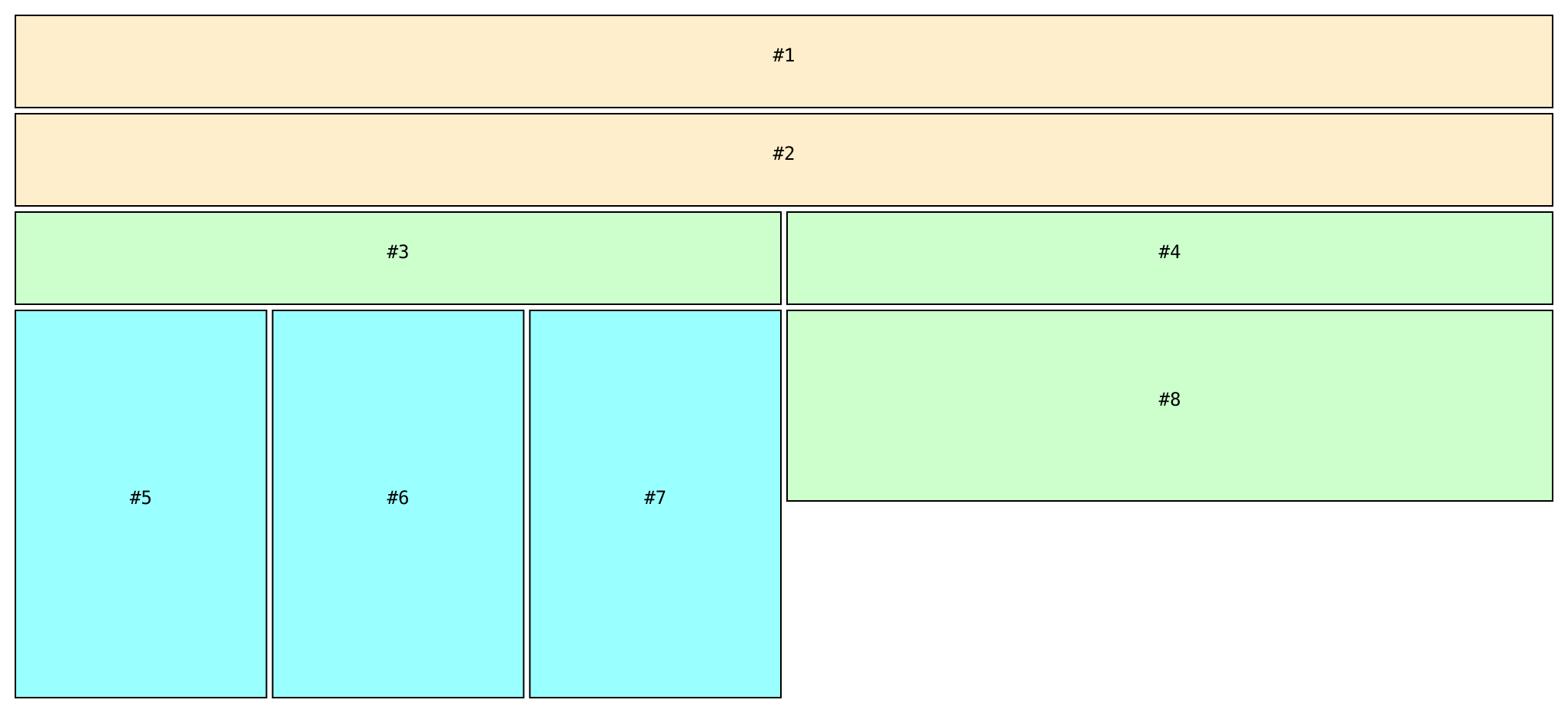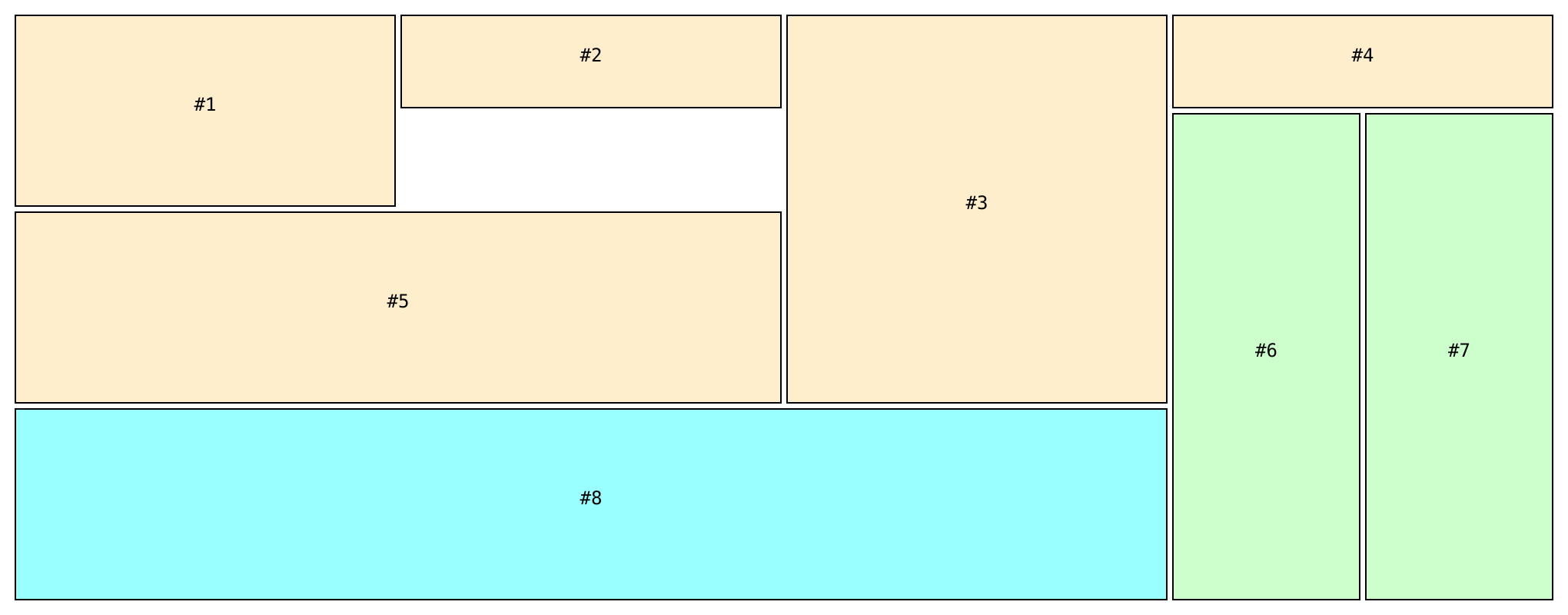This is a standalone project, maintained as part of the @thi.ng/umbrella monorepo and anti-framework.
Configurable nested 2D grid layout generators.
Currently, this package features two grid layout strategies (each based on requesting/allocating cells of a desired size), as well as more general supporting types to define other layout types / implementations using the same shared API.
A brief overview and comparison of the available strategies is provided further below.
STABLE - used in production
Search or submit any issues for this package
- @thi.ng/imgui - Immediate mode GUI with flexible state handling & data only shape output
yarn add @thi.ng/layoutES module import:
<script type="module" src="https://cdn.skypack.dev/@thi.ng/layout"></script>For Node.js REPL:
const layout = await import("@thi.ng/layout");Package sizes (brotli'd, pre-treeshake): ESM: 1.19 KB
Several projects in this repo's /examples directory are using this package:
| Screenshot | Description | Live demo | Source |
|---|---|---|---|
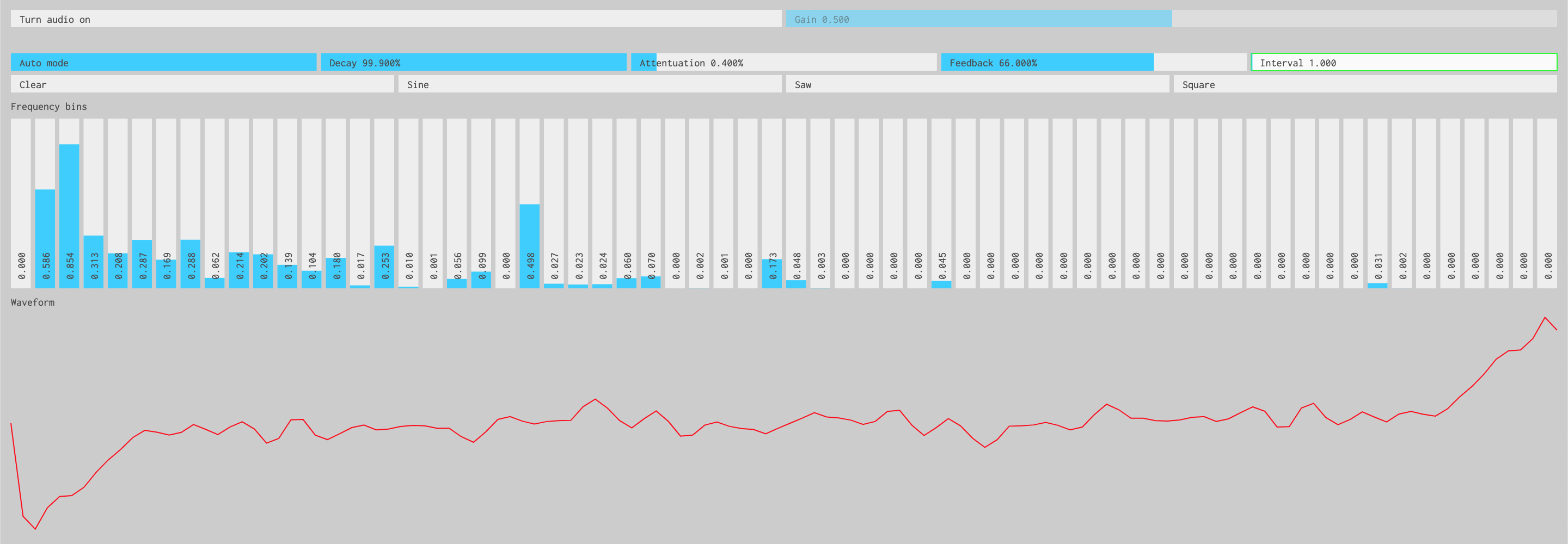 |
Interactive inverse FFT toy synth | Demo | Source |
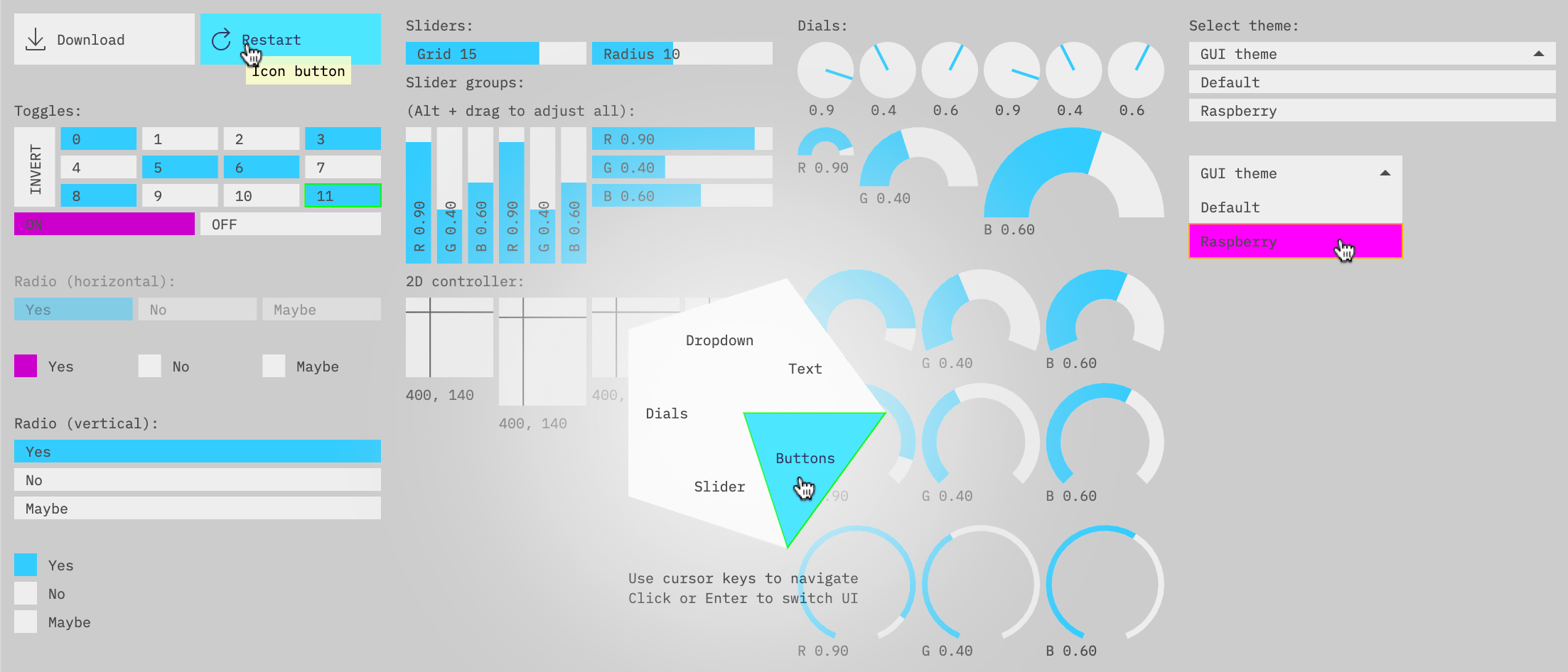 |
Canvas based Immediate Mode GUI components | Demo | Source |
 |
Minimal IMGUI usage example | Demo | Source |
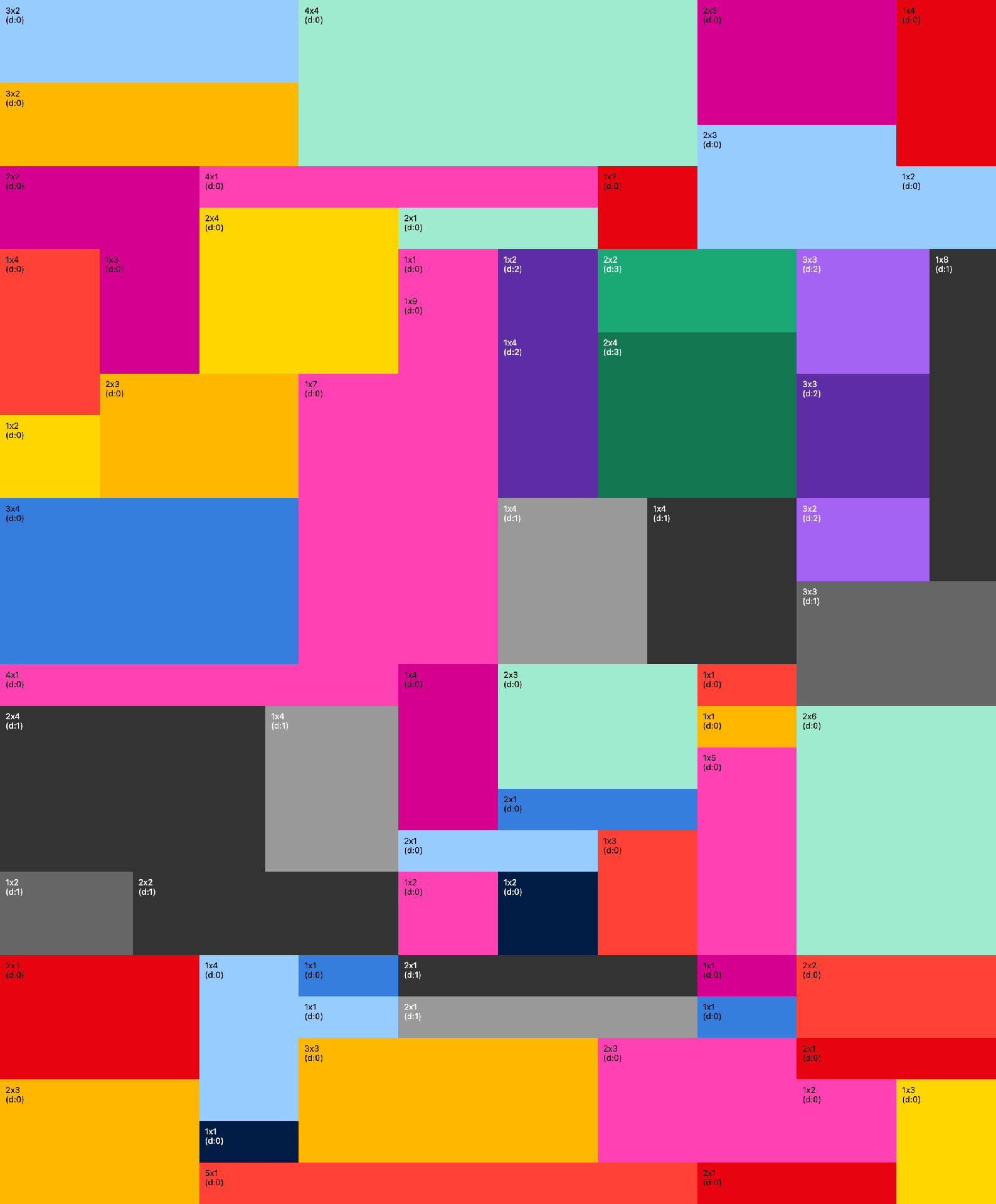 |
Randomized space-filling, nested grid layout generator | Demo | Source |
The GridLayout class supports infinite nesting and column/row-based
space allocation, based on an initial configuration and supporting
multiple column/row spans.
The code producing this layout (incl. the visualization itself):
import * as g from "@thi.ng/geom";
import { gridLayout, type LayoutBox } from "@thi.ng/layout";
import { writeFileSync } from "fs";
// collection of generated layout cells
const cells: g.Group[] = [];
const addRect = (id: number, box: LayoutBox, fill: string) => {
console.log(box);
const shape = g.rect([box.x, box.y], [box.w, box.h], { fill });
cells.push(
g.group({}, [
shape,
g.text(g.centroid(shape)!, "#" + id, {
fill: "black",
stroke: "none",
}),
])
);
};
// create a single column layout @ position [10,10], 1000px wide
// the last values are row height and cell spacing
const layout = gridLayout(10, 10, 1000, 1, 60, 4);
// get next layout box (1st row, by default the column/row span is [1,1])
addRect(1, layout.next(), "#fec");
// { x: 10, y: 10, w: 1000, h: 60, cw: 1000, ch: 60, gap: 4, span: [ 1, 1 ] }
// 2nd row
addRect(2, layout.next(), "#fec");
// { x: 10, y: 74, w: 1000, h: 60, cw: 1000, ch: 60, gap: 4, span: [ 1, 1 ] }
// create nested 2-column layout (3rd row)
const twoCols = layout.nest(2);
addRect(3, twoCols.next(), "#cfc");
// { x: 10, y: 138, w: 498, h: 60, cw: 498, ch: 60, gap: 4, span: [ 1, 1 ] }
addRect(4, twoCols.next(), "#cfc");
// { x: 512, y: 138, w: 498, h: 60, cw: 498, ch: 60, gap: 4, span: [ 1, 1 ] }
// now nest 3-columns in the 1st column of twoCols
// (i.e. now each column is 1/6th of the main layout's width)
const inner = twoCols.nest(3);
// allocate with col/rowspan, here 1 column x 4 rows
addRect(5, inner.next([1, 4]), "#9ff");
// { x: 10, y: 202, w: 163.33, h: 252, cw: 163.33, ch: 60, gap: 4, span: [ 1, 4 ] }
addRect(6, inner.next([1, 4]), "#9ff");
// { x: 177.33, y: 202, w: 163.33, h: 252, cw: 163.33, ch: 60, gap: 4, span: [ 1, 4 ] }
addRect(7, inner.next([1, 4]), "#9ff");
// { x: 344.66, y: 202, w: 163.33, h: 252, cw: 163.33, ch: 60, gap: 4, span: [ 1, 4 ] }
// back to twoCols (2nd column)
addRect(8, twoCols.next([1, 2]), "#cfc");
// { x: 512, y: 202, w: 498, h: 124, cw: 498, ch: 60, gap: 4, span: [ 1, 2 ] }
// export as SVG
writeFileSync(
"export/readme-grid.svg",
g.asSvg(
g.svgDoc(
{
__bleed: 10,
font: "12px Menlo, monospace",
align: "center",
baseline: "middle",
},
...cells
)
)
);An extension of GridLayout which tracks individual column-based heights and so can create more complex, irregular, packed, space-filling layout arrangements. This layout algorithm prioritizes the column(s) with the lowest height.
This class also provides a
.availableSpan()
method to find available space and help equalize columns and fill/allocate any
bottom gaps.
IMPORTANT: As with GridLayout, nested layouts MUST be completed first before
requesting new cells (aka LayoutBoxes) from a parent, otherwise unintended
overlaps will occur.
The code producing this layout (incl. the visualization itself):
import * as g from "@thi.ng/geom";
import { stackedLayout, type LayoutBox } from "@thi.ng/layout";
import { writeFileSync } from "fs";
// collection of generated layout cells
const cells: g.Group[] = [];
const addRect = (id: number, box: LayoutBox, fill: string) => {
console.log(box);
const shape = g.rect([box.x, box.y], [box.w, box.h], { fill });
cells.push(
g.group({}, [
shape,
g.text(g.centroid(shape)!, "#" + id, {
fill: "black",
stroke: "none",
}),
])
);
};
// create a 4-column layout @ position [0,0], 1000px wide
// the last values are row height and cell spacing
const layout = stackedLayout(0, 0, 1000, 4, 60, 4);
// get next layout box (1st column)
addRect(1, layout.next([1, 2]), "#fec");
// { x: 0, y: 0, w: 247, h: 124, cw: 247, ch: 60, gap: 4, span: [ 1, 2 ] }
// 2nd column
addRect(2, layout.next(), "#fec");
// { x: 251, y: 0, w: 247, h: 60, cw: 247, ch: 60, gap: 4, span: [ 1, 1 ] }
// 3rd column
addRect(3, layout.next([1, 4]), "#fec");
// { x: 502, y: 0, w: 247, h: 252, cw: 247, ch: 60, gap: 4, span: [ 1, 4 ] }
// 4th column
addRect(4, layout.next([1, 1]), "#fec");
// { x: 753, y: 0, w: 247, h: 60, cw: 247, ch: 60, gap: 4, span: [ 1, 1 ] }
// 2x2 span
// (note that this will create a gap in the 2nd column)
addRect(5, layout.next([2, 2]), "#fec");
// { x: 0, y: 128, w: 498, h: 124, cw: 247, ch: 60, gap: 4, span: [ 2, 2 ] }
const inner = layout.nest(2);
addRect(6, inner.next([1, 5]), "#cfc");
// { x: 753, y: 64, w: 121.5, h: 316, cw: 121.5, ch: 60, gap: 4, span: [ 1, 5 ] }
addRect(7, inner.next([1, 5]), "#cfc");
// { x: 878.5, y: 64, w: 121.5, h: 316, cw: 121.5, ch: 60, gap: 4, span: [ 1, 5 ] }
// fill available space in the other columns
// (depending on situation, this might have to be done multiple times
// to fill all available space, please consult documentation)
addRect(8, layout.next(layout.availableSpan()), "#9ff");
// { x: 0, y: 256, w: 749, h: 124, cw: 247, ch: 60, gap: 4, span: [ 3, 2 ] }
// export as SVG
writeFileSync(
"export/readme-stacked.svg",
g.asSvg(
g.svgDoc(
{
__bleed: 10,
font: "12px Menlo, monospace",
align: "center",
baseline: "middle",
},
...cells
)
)
);If this project contributes to an academic publication, please cite it as:
@misc{thing-layout,
title = "@thi.ng/layout",
author = "Karsten Schmidt",
note = "https://thi.ng/layout",
year = 2019
}© 2019 - 2024 Karsten Schmidt // Apache License 2.0
